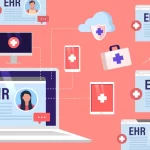
Decoding the Future: Top 10 Health Informatics Trends of 2023 That Will Revolutionize Healthcare
August 31, 2023Healthcare is an industry that is constantly in flux thanks to rapid advancements in technology. The year 2023 marks a watershed moment for health informatics, the interdisciplinary field that applies information technology to healthcare. The stakes have never been higher; with a global population increasingly reliant on digital healthcare solutions, understanding the trends shaping this landscape is vital for both healthcare providers and patients.
Health Data Interoperability: The Glue That Binds
Imagine the cacophony if each instrument in an orchestra played its own tune. The same could be said about healthcare systems that don’t “talk” to each other. Enter health data interoperability, a critical trend in 2023. It allows for a seamless exchange of health data across various platforms, leading to more accurate diagnoses and better patient safety. As healthcare providers increasingly adopt vendor-neutral and interoperable solutions, the fragmentation within the industry is likely to diminish.
Artificial Intelligence (AI): The New Diagnostician
AI is not just a buzzword in 2023; it’s a reality that’s augmenting healthcare at an unprecedented scale. Whether it’s predictive modeling, automated image analysis for cancer detection, or personalized treatment plans, AI algorithms sift through large datasets to provide invaluable insights. The result? Healthcare professionals are empowered to make more informed decisions, ultimately improving patient outcomes.
Data Analytics: The Unsung Hero
As the volume of healthcare data balloons, so does the importance of data analytics. Whether it’s understanding population health trends or optimizing workflows, analytics in health informatics provide the foundation for evidence-based decision-making. What this means is that care providers can identify problem areas and make adjustments, which ultimately leads to improved healthcare outcomes and possibly lower costs.
Value-Based Care: The North Star
2023 is increasingly seeing a shift towards value-based care, a model that stresses patient satisfaction and outcomes over the volume of services rendered. This is enabled by data-driven decision-making, emphasizing not just the ‘what’ but the ‘how’ and ‘why’ of healthcare. This approach aligns well with the financial incentives for healthcare providers, making it a win-win situation for all stakeholders involved.
Internet of Medical Things (IoMT): A Lifeline in Digital Health
If healthcare had a nervous system, the Internet of Medical Things (IoMT) would be it. This vast network of connected medical devices—from wearable fitness trackers to smart insulin pens—helps with real-time patient monitoring and data analysis. This technology enables preventive care strategies, chronic disease management, and even more efficient telemedicine solutions.
Cybersecurity and Data Privacy: Guardians of the Healthcare Galaxy
With great power comes great responsibility, and as healthcare systems are increasingly digitized, cybersecurity has become more crucial than ever. The onus is on health informatics professionals to protect patient data from cyber threats, making investment in robust cybersecurity measures a priority in 2023.
Remote Patient Monitoring (RPM): A Window to Remote Care
RPM technology has evolved to become more than just a convenience; it’s a necessity. With healthcare costs soaring, RPM serves as a tool to monitor patients outside of conventional clinical settings, thereby reducing hospital readmissions and enabling timely interventions.
Cloud Computing: The Invisible Backbone
The cloud is revolutionizing healthcare by providing a secure and scalable platform for data sharing. Whether it’s streamlining administrative tasks or supporting distributed healthcare models, cloud computing’s flexibility and cost-effectiveness will make it indispensable in 2023.
Augmented Reality (AR) and Virtual Reality (VR): The Game Changers
AR and VR technologies are moving beyond the realm of video games and into the surgical rooms and therapy centers. Whether it’s helping surgeons navigate complex procedures or allowing patients to manage pain through immersive experiences, these technologies offer exciting potential.
Medical Devices and IoT: The Choreographers of Workflow
Whether it’s smart beds that automatically adjust to optimize patient comfort or RFID chips that keep track of hospital equipment, IoT in medical devices is making healthcare more efficient, one byte at a time.
In Summary
Health informatics in 2023 is not just a supportive field; it’s a transformative force that is crucial to the evolution of healthcare. As we navigate this increasingly digitized world, staying abreast of these top 10 trends can provide a road map for what healthcare can—and will—look like in the near future. So, whether you’re a healthcare provider, a patient, or simply someone interested in the future of healthcare, these trends offer a panoramic view of a landscape that is ever-changing but always exciting.

















